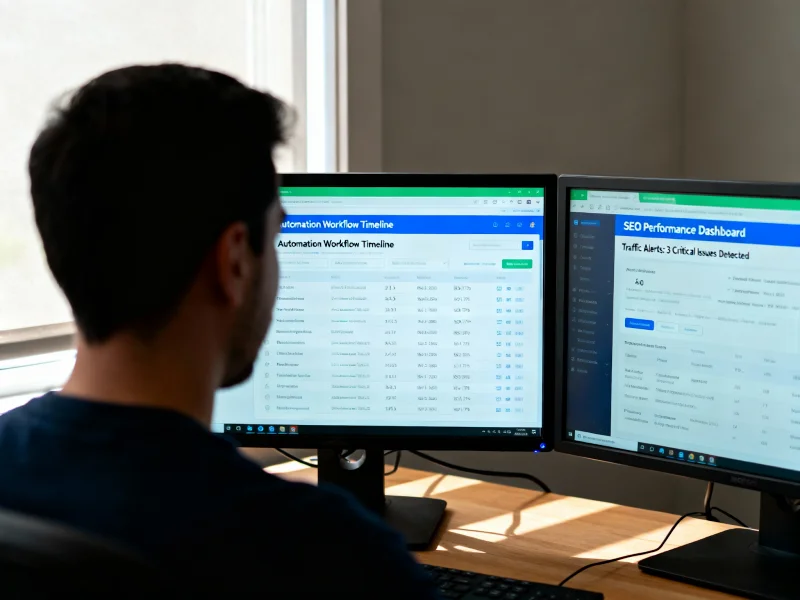Does SEO Improve Website Traffic?
SEO services play a crucial role in increasing website traffic by enhancing online visibility and attracting the right audiences.
By optimizing your content with relevant keywords and improving your website's ranking, you can attract more organic traffic without relying solely on paid advertisements.
On-page optimization, which includes strategic keyword placement and improving site structure, boosts search engine rankings.
Consistent content updates and thorough technical audits ensure that the website remains user-friendly and authoritative. This comprehensive approach not only raises brand awareness but also builds trust with users.
By understanding and applying these principles, businesses can effectively leverage SEO to achieve sustained growth and increased traffic.
Key Takeaways
- SEO services enhance online visibility by optimizing website content for relevant keywords, which helps attract targeted traffic from search engines.
- By focusing on user experience through mobile optimization and quick loading times, SEO encourages visitors to engage with the site for longer periods.
- Regular updates to the content and thorough technical audits help ensure that the website remains competitive and user-friendly, which in turn boosts organic traffic.
- Creating high-quality content and implementing effective link-building strategies establish authority, increasing both credibility and trust among potential customers.
- Ongoing measurement and adaptation to current SEO trends support sustained growth in organic traffic over time. This approach not only drives more visitors to your website but also enhances the overall experience for users, aligning with best practices in online engagement.
Understanding SEO Principles
In the field of digital marketing, a solid grasp of SEO principles is essential for improving online visibility and increasing website traffic. A key component of this knowledge is keyword analysis, which focuses on identifying the relevant search terms potential customers are using. Long-tail keywords—phrases made up of three or more words—are particularly effective as they align with specific search intents, attracting a more targeted audience. Tools such as Google Keyword Planner and SEMrush play a crucial role in this research process. Additionally, understanding keyword intent can further enhance the effectiveness of your keyword strategy.
On-page optimization enhances the effectiveness of keyword analysis. This involves strategically placing keywords in title tags and meta descriptions, which can lead to significantly higher click-through rates. For example, placing relevant keywords at the beginning of title tags can improve visibility in search results. Using clear and descriptive headings (H1, H2) not only organizes content but also helps search engines crawl the site more effectively. Additionally, high-quality content is crucial as it attracts and retains visitors on the site.
It is important to integrate keywords naturally throughout the content, including in URLs, to prevent keyword stuffing and ensure readability. A well-structured approach to keyword analysis and on-page optimization is essential for maximizing the impact of SEO strategies and enhancing overall website performance.
Benefits of SEO Services
The advantages of SEO services are varied and play a crucial role in enhancing online visibility while attracting targeted traffic. By optimizing websites for search engines, businesses can achieve long-term cost efficiency and maintain a steady stream of relevant visitors. This strategic approach not only boosts search rankings but also establishes credibility and trust with potential customers. With a focus on user experience and valuable content, SEO services provide the necessary tools to help businesses thrive in the digital landscape. Additionally, improving search engine rankings through targeted keyword strategies significantly enhances a website's overall visibility. Furthermore, organic search accounts for 53% of all website traffic, emphasizing the importance of effective SEO services.
Increased Visibility Online
Enhanced online visibility is a crucial asset for businesses aiming to succeed in today's digital landscape. By utilizing SEO services, companies can achieve greater visibility, which directly leads to increased organic traffic. When a website ranks higher on search engine results pages, it naturally attracts more visitors, strengthening the overall online presence.
One of the primary advantages of improved visibility is the boost in brand awareness. As potential customers encounter a business more frequently in their search results, it cultivates credibility and trust, establishing the brand as a reliable resource. This competitive advantage is noteworthy; businesses that effectively optimize their websites are positioned to surpass their competitors and enhance their sales potential. Additionally, a focus on search engine algorithms helps ensure that the content remains relevant and aligned with user search behaviors.
Effective SEO strategies—such as keyword optimization, high-quality content creation, and local SEO—play a significant role in achieving increased visibility. These techniques not only improve search rankings but also drive offline traffic for businesses with physical locations. Regular performance analysis through SEO analytics is essential for maintaining and enhancing visibility metrics, ensuring that businesses remain competitive in the online environment. Ultimately, increased visibility through SEO services promotes growth, engagement, and sustained success in the challenging online marketplace.
Targeted Traffic Attraction
Achieving increased visibility is just the starting point; the real value of SEO services lies in attracting targeted traffic. By implementing strategic keyword research and intent mapping, SEO services effectively align your content with the specific segments of your target audience. This method not only boosts organic web traffic but also enhances user experience through mobile optimization and fast page loading speeds, ensuring that visitors engage meaningfully with your site.
SEO services also play a significant role in elevating brand awareness by consistently positioning your website in search results, which builds recognition and trust. High-quality, authoritative content demonstrates your expertise, while strategic social media integration brings additional traffic sources to your site. Moreover, successful SEO strategies are essential for maintaining a competitive edge in a crowded online marketplace.
The emphasis on targeted traffic improves conversion rates, as optimized landing pages and clear calls-to-action attract high-quality leads that are more likely to convert into customers. Effective link-building strategies help you stand out from competitors, securing a strong presence in search results. Ultimately, the targeted traffic attraction enabled by SEO services is essential for any business aiming to connect with its ideal audience, driving sustainable growth and success.
Long-term Cost Efficiency
Long-term cost efficiency is a key benefit of implementing SEO services, as it creates a sustainable model for generating traffic that supports businesses over time. Unlike pay-per-click (PPC) advertising, which requires ongoing expenditures, SEO can lead to lasting savings by attracting organic traffic without the need for constant investment. As companies enhance their websites, they often discover that their organic traffic can rival or even exceed that of PPC campaigns, resulting in a lower cost per acquisition.
Investing in a comprehensive SEO strategy is typically more economical than fragmented marketing efforts. While the costs for SEO services may range from $1,500 to $5,000 monthly, the potential return on investment over time can be substantial. Effective SEO encompasses key aspects such as high-quality content creation, thorough keyword research, and technical optimizations that improve a website's performance and visibility. Moreover, improved rankings on SERPs can significantly increase clicks and organic traffic over time.
Being responsive to evolving SEO trends helps businesses maintain a competitive edge. A well-implemented SEO strategy not only boosts traffic but also enhances brand awareness and credibility, paving the way for sustainable growth and profitability. Therefore, embracing SEO is a strategic choice that promotes long-term cost efficiency and success in the digital marketplace.
Key SEO Elements
Effective SEO hinges on the careful application of content structuring techniques and the development of linkable assets. Well-organized content not only improves user experience but also boosts visibility in search engines. Creating significant linkable assets is essential for attracting authoritative backlinks. These elements are vital in enhancing a website's overall search performance and credibility, ensuring that your content meets the needs of users while adhering to best practices in the field. Additionally, understanding search intent is crucial for crafting content that resonates with your target audience and improves engagement.
Content Structuring Techniques
How can content structuring techniques significantly influence your website's SEO performance? Effective content structuring plays a critical role in enhancing visibility and improving user engagement. Optimizing headers by utilizing H1, H2, and H3 tags not only organizes your content but also assists search engines in indexing it, which can increase your site's relevance. Enhancing metadata with keyword-rich titles and concise meta descriptions can significantly improve click-through rates.
Implementing topic clustering allows you to create interconnected content centered around core themes, enhancing both site authority and user experience. This organized approach demonstrates to search engines that your site is a comprehensive resource on the subject. Structuring your content to target featured snippets can also elevate your site in search results, as clear headings and formatted lists make it simpler for Google to extract relevant information.
A well-defined content hierarchy, combined with strategic internal linking, improves site exploration and reinforces your overall SEO strategy. By prioritizing these content structuring techniques, you establish a strong foundation for increased website traffic and enhanced user engagement.
Linkable Asset Creation
Content structuring techniques form the foundation for effective SEO strategies, including the development of linkable assets. By creating unique and relevant content, businesses can attract valuable backlinks that enhance their online presence. The types of linkable assets vary and may include infographics, in-depth articles, videos, and downloadable resources. It is crucial that these assets address the interests and needs of the target audience, providing information that is not readily available elsewhere.
Optimization plays a key role; assets should include relevant keywords to ensure visibility in search engine results. To promote this content effectively, employing strategies such as social media engagement, participation in online communities, and influencer marketing can significantly boost the chances of acquiring backlinks.
A well-planned approach involves identifying the target audience, analyzing competitor offerings, and using techniques like the skyscraper method to create superior content. Tools such as SEMrush and BuzzSumo can be beneficial in discovering link opportunities and optimizing the creation of these assets.
The benefits of linkable assets are considerable; they not only drive organic traffic but also strengthen domain authority and enhance user experience. By acting as magnets for external links, high-quality assets increase site credibility and improve search engine rankings, ultimately contributing to a successful SEO strategy.
Effective SEO Strategies
The foundation of any effective digital marketing campaign is the implementation of strong SEO strategies. On-page optimization is crucial, which involves refining title tags and meta descriptions to accurately represent webpage content. Thoughtful keyword placement within headings and body text aids search engines in understanding the content while enabling rich snippets to improve visibility in search results.
Page speed plays a vital role in user experience; optimizing images and choosing lightweight themes can make a significant difference. Regularly updating content ensures that information remains relevant, encouraging visitors to return to the site.
Technical audits are essential for identifying and addressing issues such as broken links and duplicate content. A well-structured website enhances navigation and indexing, while ensuring mobile responsiveness guarantees accessibility across various devices. Using HTTPS and managing canonical URLs enhances security and prevents content duplication. Finally, maintaining accurate sitemaps helps search engines index your site efficiently. Additionally, implementing schema markup can significantly improve your website's visibility in search results by helping search engines better understand your content.
SEO Statistics Overview
In today's digital landscape, grasping SEO statistics is critical for businesses seeking to improve their online visibility and attract targeted traffic. Several compelling statistics underscore the significance of organic search and its role in establishing website authority.
- 53% of website traffic stems from organic search, highlighting its potential for audience engagement.
- 95% of search traffic is focused on the first page of search results, illustrating the importance of achieving strong SERP rankings.
- 49% of marketers identify organic search as delivering the highest ROI, reinforcing its value in digital marketing strategies.
To leverage these SEO trends effectively, businesses should prioritize keyword research, content optimization, and backlink development. A single position improvement in rankings can boost click-through rates (CTR) by 30.8%, while URLs incorporating keywords tend to achieve a 45% higher CTR. Furthermore, high-quality backlinks signal valuable content to search algorithms, which can enhance overall user engagement. Additionally, implementing effective SEO practices can significantly improve website performance and search engine rankings.
Tools for SEO Monitoring
Effective SEO monitoring tools are crucial for businesses seeking to track their online performance and refine their strategies. These tools allow organizations to evaluate various metrics, offering valuable insights into their website's health and effectiveness.
Among the free options, Google Analytics and Google Search Console are noteworthy. Google Analytics provides real-time tracking of traffic sources and user engagement, while Google Search Console assists in identifying crawl errors and monitoring keyword rankings. For those considering paid tools, Ahrefs and SEMrush deliver a wide range of features, including backlink analysis and competitor research. Additionally, tools like Woorank can provide instant SEO improvement suggestions, helping to pinpoint areas for enhancement.
When comparing SEO tools, it's essential to examine each tool's capabilities, such as technical SEO audits and keyword performance tracking. For example, Moz Pro is particularly strong in monitoring key metrics, while SE Ranking offers in-depth competitive analysis. This approach ensures you select the right tools to support your SEO efforts effectively.
Building Quality Backlinks
Regularly prioritizing the building of quality backlinks is essential for enhancing a website's authority and improving its search engine ranking. High-quality backlinks act as endorsements from credible sites, signaling to search engines that your content holds significant value. Effective link-building strategies focus on acquiring backlinks from reputable sources with high domain ratings.
Key Backlink Strategies
To achieve optimal backlink quality, consider the following approaches:
- Content Creation: Develop informative and unique resources that others will want to link to, such as expert guides, infographics, or interactive tools.
- Guest Blogging: Collaborate with niche-related websites to write engaging guest posts, which can increase your exposure and provide valuable backlinks.
- Influencer Outreach: Connect with industry influencers to broaden your content's reach and encourage them to link to your work.
It is also important to ensure that backlinks are naturally integrated within your content rather than placed in footers or sidebars. Regular audits of your backlink profile are crucial for maintaining quality and avoiding penalties. By implementing these strategies, you can establish a strong link profile that enhances your website's visibility and credibility in the online landscape. Additionally, focusing on acquiring editorially placed links can significantly improve the perceived value of your content and boost your rankings.
Content Structure Importance
A well-organized content structure is essential for improving user experience and optimizing for search engines. By implementing a pyramid structure, you can ensure that the homepage directs visitors to category pages, which then link to more specific content. This hierarchy reduces internal competition for keywords, allowing individual pages to rank effectively while maintaining their authority.
Benefits of Content Structure
- Enhanced Navigation: A logical structure improves user navigation and ensures visitors can easily find what they're looking for, leading to increased engagement and lower bounce rates.
- Better Indexing: Search engines can efficiently crawl and index your website, improving visibility for all indexed pages.
- Targeted Rankings: Clear content hierarchies help each page focus on specific keywords, reducing competition between your own pages for the same search terms.
Incorporating subheadings (H2-H6) is vital in this organization. Subheadings break up the content into manageable sections, enhancing readability and user engagement. They also provide opportunities for keyword placement, ensuring that relevant terms are optimized for both users and search engines.
A clear, hierarchical structure helps search engine algorithms understand human reading patterns, increasing the chances that high-quality content will be prioritized in rankings. By strategically linking from long-tail keyword pages to higher-level pages, you create a navigable structure that helps Google comprehend the relationship between your content. Additionally, properly configured robots.txt files ensure effective crawling and indexing by search engines, further enhancing visibility.
Ultimately, a well-defined content structure not only attracts traffic but also ensures that visitors can easily find and engage with relevant information, resulting in a better overall experience.
Measuring SEO Success
Measuring SEO success relies on the ability to track and analyze various performance metrics that reflect a website's visibility and user engagement. Effective tracking enables businesses to assess the impact of their SEO strategies and make informed adjustments.
Essential Metrics to Monitor
- Search Engine Result Pages (SERPs) Position: Knowing your website's ranking is vital for understanding its visibility.
- Organic Traffic and Click-Through Rate (CTR): These metrics reveal how effectively users are engaging with your content.
- Bounce Rate and Time on Page: High bounce rates may indicate issues with user experience or content relevance.
- Engagement Metrics: High engagement rates, ideally between 60% to 70%, indicate strong user interaction with the site.
- Backlink Profile: The quality and quantity of backlinks are critical indicators of your website’s authority and SEO performance.
Regular monitoring of Core Web Vitals can provide insights into user experience and site performance, further enhancing your SEO efforts.
Tools for Measuring SEO Success
To track these metrics effectively, use tools like:
- Google Analytics: Provides insights into traffic sources, user behavior, and key performance indicators.
- Google Search Console: Tracks keyword rankings, identifies crawl errors, and monitors site performance in search results.
- Ahrefs and SEMrush: Offer advanced tracking features, including backlink analysis and competitive benchmarking.
Using these tools, you can continuously optimize your strategy, ensuring sustained growth in visibility and traffic.
Conclusion
In summary, SEO services are essential for increasing website traffic by optimizing key elements such as content quality, keyword usage, and backlink profiles. By applying effective strategies based on SEO principles, businesses can enhance their visibility on search engine results pages. Utilizing strong analytics and monitoring tools allows for measuring success and adjusting approaches as needed. A thorough understanding of SEO promotes sustainable growth in online presence and user engagement, which significantly influences traffic levels.
Want more visitors to your site? Authority Solutions®, a trusted SEO services company, specializes in driving targeted traffic through effective SEO strategies. We focus on attracting users actively searching for your products or services. If you're ready to see a significant increase in website traffic and want to know more about our search engine optimization services, get in touch with us for a free consultation.
FAQs
1. How can technical SEO, a part of SEO services, help drive traffic to my website?
Technical SEO improves your website’s backend elements—like site speed, mobile usability, and crawlability—so search engines can index your content more efficiently. These improvements help search engines understand your site structure, which supports higher rankings. As part of a complete SEO strategy, technical SEO contributes directly to increased visibility and traffic by aligning your website with search engine requirements. The better your site performs technically, the more likely it is to attract qualified visitors.
2. Besides increasing traffic, what other benefits do SEO services offer?
SEO services do more than just increase website traffic. They also improve website design and user experience, boost brand visibility, and build credibility. By optimizing your website for better SEO performance, you not only attract more visitors to your website but also increase the likelihood of attracting qualified traffic and traffic and conversions.
3. What are some effective off-page SEO strategies besides link building that can drive traffic?
While link building is a key off-page tactic, other off-page SEO strategies can also drive traffic. These include social media marketing, brand mentions, and local citations. These off-page SEO strategies expand your online presence and help increase traffic by driving traffic to your website using other means.
4. How does understanding SEO basics help in improving overall website traffic?
Understanding SEO basics provides a foundation for implementing effective SEO strategies. Knowing how search engines work, the importance of keyword research, and the difference between on-page and off-page helps you optimize your website for better visibility and drive traffic to your website. Understanding SEO is important for SEO.
5. If I have a new website, how quickly can I expect SEO to drive traffic?
SEO traffic takes time, especially for a new website. It takes time for search engines to crawl, index, and rank your website. While you might see some initial results from on-page SEO, it generally takes several months to see significant increased organic traffic from SEO generates traffic.
6. What role does on-page SEO play in increasing website traffic and conversions?
On-page SEO focuses on optimizing elements within your website, such as content, title tags, and meta descriptions. By optimizing these elements with relevant keywords, on-page SEO helps search engines understand what your website offers, increasing the chances of attracting targeted traffic and improving traffic and conversions.
7. How can I use SEO to attract targeted traffic interested in my product or service?
Using SEO effectively involves thorough keyword research to identify terms your target audience uses. By optimizing your website content and metadata with these keywords, you increase the likelihood of attracting targeted traffic genuinely interested in your product or service. This helps ensure that your website attracts the right visitors to your website.
8. What are some common SEO mistakes that can harm my SEO efforts and traffic?
Several SEO mistakes can harm your SEO efforts. These include keyword stuffing, thin content, ignoring mobile optimization, and using black hat SEO tactics. These mistakes can negatively impact your rankings and reduce traffic to your site. It is important to ensure that your website remains optimized.
9. What is the power of SEO, and how does it compare to other marketing methods for driving traffic?
The power of search engine optimization lies in its ability to drive sustainable, organic traffic without relying solely on paid advertising. Unlike paid ads, which stop driving traffic when you stop paying, good SEO generates traffic consistently over time, making it a valuable long-term investment.
10. How can an SEO audit help improve my website’s SEO performance and drive more traffic?
An SEO audit analyzes various aspects of your website to identify areas for improvement. It checks for technical issues, on-page optimization opportunities, and off-page SEO strategies. By addressing these issues, an SEO audit helps improve your website’s SEO performance and drive traffic to your website.









